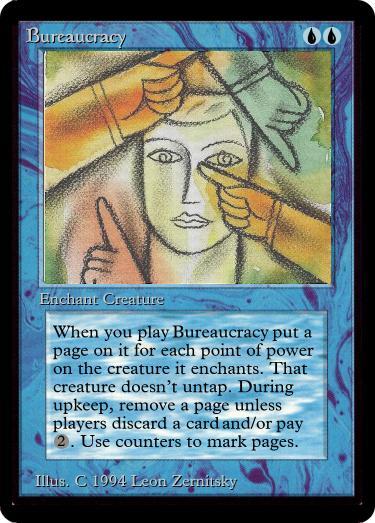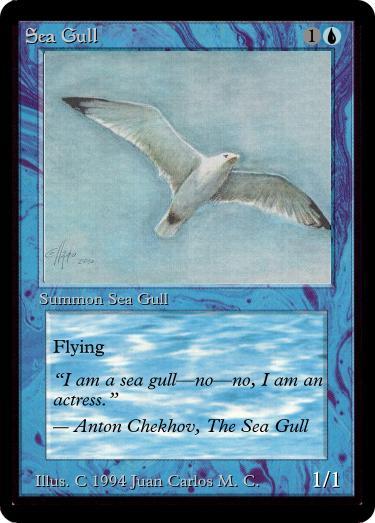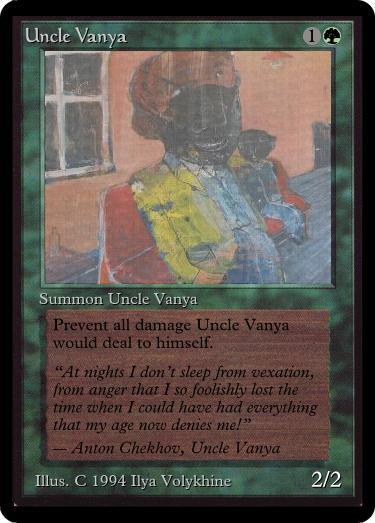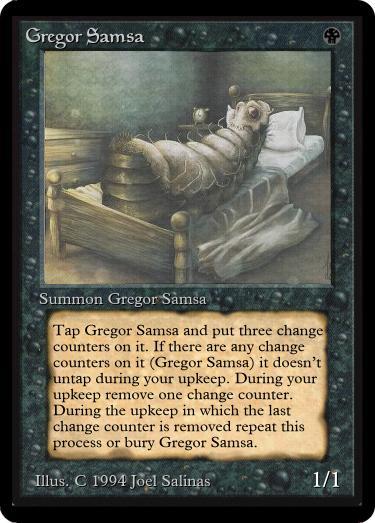
When Magic was first released in 1993 it was met with critical acclaim. The idea of taking these myths and fantasy tropes and reducing them to a collectible item, and a populist one at that, spoke to the spirit of the times. They were addicting, ironic, and above all consumable; perfect for the anger and energy of a post-Cold War, globalized world. With the success of the first set, Alpha, and the later Warholian reproductions Beta and Unlimited, the public wondered what milieu Garfield would tackle next. Arabian Nights dealt with ideas of appropriation in a U.S. becoming more embroiled in Middle Eastern conflicts (with cards like the masterpiece [card]Juzám Djinn[/card] which pokes subtle fun at the Iran-Contra Scandal) while The Dark confronted environmental issues in a neo-gothic aesthetic ([card]Ashes to Ashes[/card], [card]Brainwash[/card], [card]Marsh Gas[/card]).
While Magic has always been very socially conscious with its parallels, such as New Phyrexia as a parable of gentrification or Onslaught Block as a mirror of how we perpetuate genocide, I think it has become too brazen, even over-the-top, in its political statements. Gone is the subtlety of cards like [card]Goblin Balloon Brigade[/card]. Instead we are left with shlock like [card]Return to the Ranks[/card]. We get it. 9/11 happened. I’d like to take a moment to hearken back to a time when Magic was designed, not just manufactured, and focus on a set, half-finished yet full of promise. Magic: Motherland.
While many of you know that Richard (I can call him that) holds a PhD in Mathematics, few know that his undergrad was in Russian literature. You can see traces of the writings of Dostoyevsky and Gogol in his work, but it was in Motherland that he let himself indulge. Much as Arabian Nights was based on the titular collection, Motherland draws from the strongest and most enduring texts from the other side of the Curtain. And each card is a masterpiece. Take for example this card:
A chaotic mess from art to text box, Bureaucracy is wholly itself. Whose upkeep? Doesn’t untap ever? The life and/or(!) mana requirement further obfuscate this card, though it’s clear that it slows the game down. Also notice the counters, which become a recurring theme in the set.
Or take the following:
Taken from Chekhov’s play of the same name, Sea Gull is what the character Nina is. Empty. Pointless. Uninteresting. Limited fodder. The kind of thing that could be reprinted in 9th Edition and then forgotten about. Sea Gull is [card]Quag Sickness[/card] is Ke$ha is Coke Zero. Art as forgettable as the card itself. A piece of cardboard to throw away. This is by no means the only card inspired by Chekhov’s work:
The story implicit in this card is palpable. Vanya is pained but powerless to do anything about that pain. And his aggressive costing as a 2/2 for 1G encourages combat. A being who only lives by the violence he inflicts, but is too cowardly to inflict it on himself. There is this card in each of us. Complimented by its wonderful art, grotesque and confronting so that we don’t have to confront ourselves.
Of course Gogol and his work make an appearance. Akaky Akakievich Bashmachkin is a poem. Much like Uncle Vanya, so much is carried in so little text. The detail of not specifying “counter” in the second line causes us to think of the overcoats that we attempt to put on ourselves day in and day out. A marked improvement over its predecessor [card]Pearled Unicorn[/card], except for the art which Richard’s father stood for. Richard’s work was by no means limited to the Russians; Czech and Polish literature provided a fertile ground for ideas to take root:
I see a lot of parallels between the work of Richard and Franz Kafka; the shuffling, the obsession with paper and numbers, the competitiveness over small shifts in prestige. Wizards of the Coast itself has become that shadowy bureaucratic authority that Richard and Kafka set out to critique. And Gregor Samsa is a scathing critique. Life as a process of toil until death. The specification of it being Gregor Samsa, the totally arbitrary change counters, all of this speaks to the minimum wage jobs Richard was working as a starving artist at the time of Magic’s conception. And finally, my favorite card of the bunch:
This card is a home run, oozing with flavor and artistic flair. The mounting action of its murders, the weight of the counters making the card heavier and less easy to manipulate, the mere cost of a mana to kill again. Some believe the green background was a printing error but Richard was sending us a message about the savagery that lives inside of each of us.
With the slog of beat-you-over-the-head sets being released today, Battle for Zendikar being only the newest and worst in an egregious line, its important to look back at our roots. Magic was a game about self-expression made by a starving artist on a basement Xerox machine. However, I do think that Magic is coming out of a dry spell: Magic 2010 tried to recapture the essence of what made Alpha such a powerful statement, Modern Masters is a wonderful stab at nostalgia and how it alters our patterns of consumption, and I’d be lying if I said I wasn’t excited to see David Lynch’s direction in the upcoming Magic movie. As usual, the Technocrats of the Coast have not invited me to attend the Richard Garfield Memorial Hotdog Eating Contest this Sunday in Renton, but he will be in my heart.
Peace.
Evan Erwin in a Beret is a Good Gamery correspondent.





